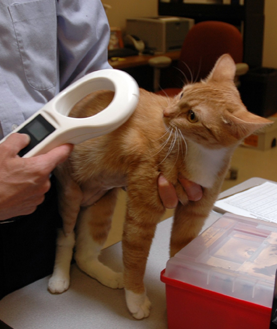Pet Microchips
A microchip is a small, electronic device that can be implanted in pets using a special needle. Once it is in place, a microchip scanner can be passed over the placement area to detect the chip. The microchip is NOT a tracking device, but it is extremely efficient in reuniting lost dogs with their owners.
How do pet microchips work?
 Lost dogs that are taken to the shelter or a veterinary clinic are always scanned for a microchip. First, someone will pass the scanner over the dog’s entire body to see if the dog has a chip. Microchips are always placed between the shoulder blades, but they can sometimes travel to other parts of the body. Numbers will appear on the device’s screen if the dog does have a microchip. If the numbers are not registered with the shelter or veterinary clinic, microchip companies will be called. They can provide the caller with the owner’s contact information or if it’s not available, with an associated phone number,such as the veterinary office where the chip was registered.
Lost dogs that are taken to the shelter or a veterinary clinic are always scanned for a microchip. First, someone will pass the scanner over the dog’s entire body to see if the dog has a chip. Microchips are always placed between the shoulder blades, but they can sometimes travel to other parts of the body. Numbers will appear on the device’s screen if the dog does have a microchip. If the numbers are not registered with the shelter or veterinary clinic, microchip companies will be called. They can provide the caller with the owner’s contact information or if it’s not available, with an associated phone number,such as the veterinary office where the chip was registered.
Are there any risks involved in microchipping pets?
There are two main risks involved with microchips:
- The chip can move out of place, making it hard to detect.
- A fibrosarcoma can develop.
However, most people feel that the benefits of microchipping their pet are greater than the risks.
How do I choose a microchip brand?
There are various microchip brands to choose from in the United States. Although all pet microchip companies offer the same product, some brands also give you the option of selecting additional services. For example, the microchip company HomeAgain offers travel assistance and emergency phone service along with the annual registration fee.






